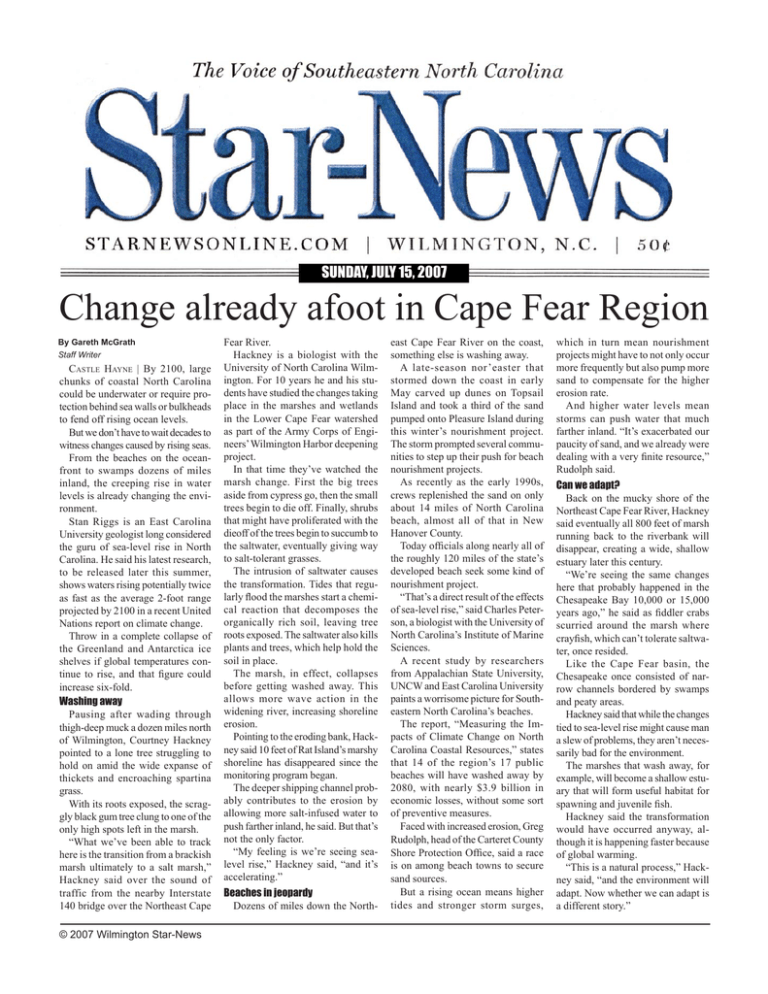Fear River. east Cape Fear River on the coast,
advertisement

SUNDAY, JULY 15, 2007 Change already afoot in Cape Fear Region By Gareth McGrath Staff Writer CASTLE HAYNE | By 2100, large chunks of coastal North Carolina could be underwater or require protection behind sea walls or bulkheads to fend off rising ocean levels. But we don’t have to wait decades to witness changes caused by rising seas. From the beaches on the oceanfront to swamps dozens of miles inland, the creeping rise in water levels is already changing the environment. Stan Riggs is an East Carolina University geologist long considered the guru of sea-level rise in North Carolina. He said his latest research, to be released later this summer, shows waters rising potentially twice as fast as the average 2-foot range projected by 2100 in a recent United Nations report on climate change. Throw in a complete collapse of the Greenland and Antarctica ice shelves if global temperatures continue to rise, and that figure could increase six-fold. Washing away Pausing after wading through thigh-deep muck a dozen miles north of Wilmington, Courtney Hackney pointed to a lone tree struggling to hold on amid the wide expanse of thickets and encroaching spartina grass. With its roots exposed, the scraggly black gum tree clung to one of the only high spots left in the marsh. “What we’ve been able to track here is the transition from a brackish marsh ultimately to a salt marsh,” Hackney said over the sound of traffic from the nearby Interstate 140 bridge over the Northeast Cape © 2007 Wilmington Star-News Fear River. Hackney is a biologist with the University of North Carolina Wilmington. For 10 years he and his students have studied the changes taking place in the marshes and wetlands in the Lower Cape Fear watershed as part of the Army Corps of Engineers’ Wilmington Harbor deepening project. In that time they’ve watched the marsh change. First the big trees aside from cypress go, then the small trees begin to die off. Finally, shrubs that might have proliferated with the dieoff of the trees begin to succumb to the saltwater, eventually giving way to salt-tolerant grasses. The intrusion of saltwater causes the transformation. Tides that regularly flood the marshes start a chemical reaction that decomposes the organically rich soil, leaving tree roots exposed. The saltwater also kills plants and trees, which help hold the soil in place. The marsh, in effect, collapses before getting washed away. This allows more wave action in the widening river, increasing shoreline erosion. Pointing to the eroding bank, Hackney said 10 feet of Rat Island’s marshy shoreline has disappeared since the monitoring program began. The deeper shipping channel probably contributes to the erosion by allowing more salt-infused water to push farther inland, he said. But that’s not the only factor. “My feeling is we’re seeing sealevel rise,” Hackney said, “and it’s accelerating.” Beaches in jeopardy Dozens of miles down the North- east Cape Fear River on the coast, something else is washing away. A late-season nor’easter that stormed down the coast in early May carved up dunes on Topsail Island and took a third of the sand pumped onto Pleasure Island during this winter’s nourishment project. The storm prompted several communities to step up their push for beach nourishment projects. As recently as the early 1990s, crews replenished the sand on only about 14 miles of North Carolina beach, almost all of that in New Hanover County. Today officials along nearly all of the roughly 120 miles of the state’s developed beach seek some kind of nourishment project. “That’s a direct result of the effects of sea-level rise,” said Charles Peterson, a biologist with the University of North Carolina’s Institute of Marine Sciences. A recent study by researchers from Appalachian State University, UNCW and East Carolina University paints a worrisome picture for Southeastern North Carolina’s beaches. The report, “Measuring the Impacts of Climate Change on North Carolina Coastal Resources,” states that 14 of the region’s 17 public beaches will have washed away by 2080, with nearly $3.9 billion in economic losses, without some sort of preventive measures. Faced with increased erosion, Greg Rudolph, head of the Carteret County Shore Protection Office, said a race is on among beach towns to secure sand sources. But a rising ocean means higher tides and stronger storm surges, which in turn mean nourishment projects might have to not only occur more frequently but also pump more sand to compensate for the higher erosion rate. And higher water levels mean storms can push water that much farther inland. “It’s exacerbated our paucity of sand, and we already were dealing with a very finite resource,” Rudolph said. Can we adapt? Back on the mucky shore of the Northeast Cape Fear River, Hackney said eventually all 800 feet of marsh running back to the riverbank will disappear, creating a wide, shallow estuary later this century. “We’re seeing the same changes here that probably happened in the Chesapeake Bay 10,000 or 15,000 years ago,” he said as fiddler crabs scurried around the marsh where crayfish, which can’t tolerate saltwater, once resided. Like the Cape Fear basin, the Chesapeake once consisted of narrow channels bordered by swamps and peaty areas. Hackney said that while the changes tied to sea-level rise might cause man a slew of problems, they aren’t necessarily bad for the environment. The marshes that wash away, for example, will become a shallow estuary that will form useful habitat for spawning and juvenile fish. Hackney said the transformation would have occurred anyway, although it is happening faster because of global warming. “This is a natural process,” Hackney said, “and the environment will adapt. Now whether we can adapt is a different story.”


